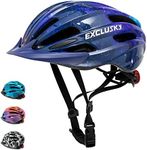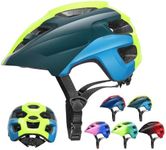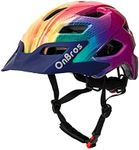Buying Guide for the Best Bike Helmet For Kids
Choosing the right bike helmet for your child is crucial for their safety and comfort while riding. A well-fitted helmet can protect your child from serious head injuries in case of an accident. When selecting a bike helmet, consider the following key specifications to ensure you pick the best one for your child's needs.Fit and SizeThe fit and size of a bike helmet are critical for safety. A helmet that is too large or too small will not provide adequate protection. Helmets usually come in different sizes, and it's important to measure your child's head circumference to find the right size. The helmet should sit level on your child's head and not tilt back. It should be snug but comfortable, with adjustable straps to ensure a secure fit. A well-fitted helmet will stay in place even when your child shakes their head.
Safety StandardsSafety standards ensure that the helmet meets certain criteria for impact protection. Look for helmets that comply with recognized safety standards such as CPSC (Consumer Product Safety Commission) in the US, or CE (Conformité Européenne) in Europe. These certifications indicate that the helmet has been tested and meets the necessary safety requirements. Choosing a helmet with these certifications ensures that it will provide adequate protection in the event of a fall or collision.
VentilationVentilation is important to keep your child cool and comfortable while riding. Helmets with multiple vents allow for better airflow, which can prevent overheating and sweating. The number and size of vents can vary, with more vents generally providing better ventilation. If your child tends to get hot easily or rides in warm climates, look for a helmet with good ventilation to keep them comfortable.
WeightThe weight of the helmet can affect your child's comfort and willingness to wear it. Lighter helmets are generally more comfortable and less tiring to wear for extended periods. However, they should still provide adequate protection. When choosing a helmet, consider the balance between weight and safety features. A lightweight helmet that meets safety standards is ideal for ensuring your child stays protected without feeling burdened.
AdjustabilityAdjustability features such as adjustable straps, dial-fit systems, and removable padding can help achieve a better fit. These features allow the helmet to grow with your child and provide a customized fit. Helmets with good adjustability can be more comfortable and secure, reducing the likelihood of the helmet shifting during a ride. Look for helmets with easy-to-use adjustment mechanisms to ensure a proper fit every time.
VisibilityVisibility features such as bright colors, reflective elements, and built-in lights can enhance your child's safety by making them more visible to others. Brightly colored helmets are easier to spot, especially in low-light conditions. Reflective elements and lights can further increase visibility during evening rides or in areas with poor lighting. Choosing a helmet with good visibility features can help prevent accidents by ensuring your child is seen by others.
ComfortComfort is key to ensuring your child wears their helmet consistently. Look for helmets with soft padding, a comfortable chin strap, and a design that doesn't cause pressure points. Some helmets also have moisture-wicking liners to keep sweat away from the skin. A comfortable helmet will be more enjoyable for your child to wear, encouraging them to keep it on during their rides.
















